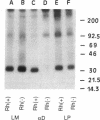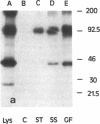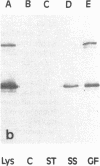Abstract
Immunoglobulin G (IgG) autoantibodies of 20 patients with autoimmune hemolytic anemia (AHA) were used in immunoaffinity assays with surface-radioiodinated human red blood cells (RBCs), and detergent-solubilized products were analyzed by SDS-PAGE/autoradiography. Four membrane proteins were identified as candidate autoantigens: a nonglycosylated polypeptide with an apparent molecular mass of 34 kD (p34) that was expressed in all available RBC phenotypes except Rhnull but differed consistently in apparent molecular mass from the 32-kD Rh(D) polypeptide co-isolated by IgG allo-anti-D; a heterogenous 37-55-kD glycoprotein, also deficient in Rhnull RBCs, which disappeared after deglycosylation by N-glycanase, with the appearance of a sharp, new approximately 31-kD band distinct from p34 and from Rh(D) polypeptide; a approximately 100-kD major membrane glycoprotein identified by immunoblotting as the band 3 anion transporter; and glycophorin A (GPA), also confirmed by immunoblotting. GP37-55 was not seen in the absence of p34, and both proteins are likely to be members of the Rh family. Indeed, a 34-kD polypeptide band and 37-55-kD poly-disperse "smear," isolated concurrently from the same labeled RBCs by IgG allo-anti-e, were indistinguishable from their autoantibody-isolated counterparts and may well be the same protein identified at different epitopes by the auto- and allo-antibodies. Individual AHA patients' autoantibodies isolated p34 and gp37-55, alone or in combination with band 3 (nine cases); strong band 3 alone (five cases); and combinations of band 3 with GPA (six cases). The autoantibodies of three additional patients whose AHA had been induced by alpha-methyldopa also isolated p34 and gp37-55.
Full text
PDF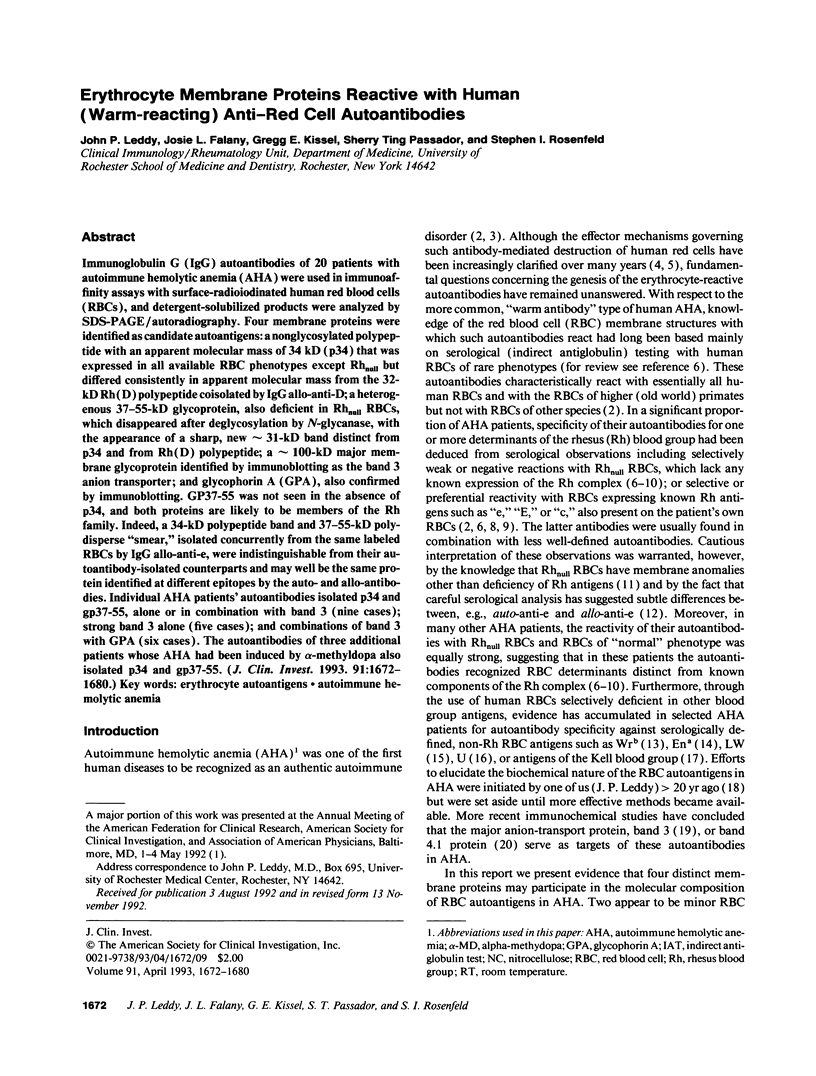
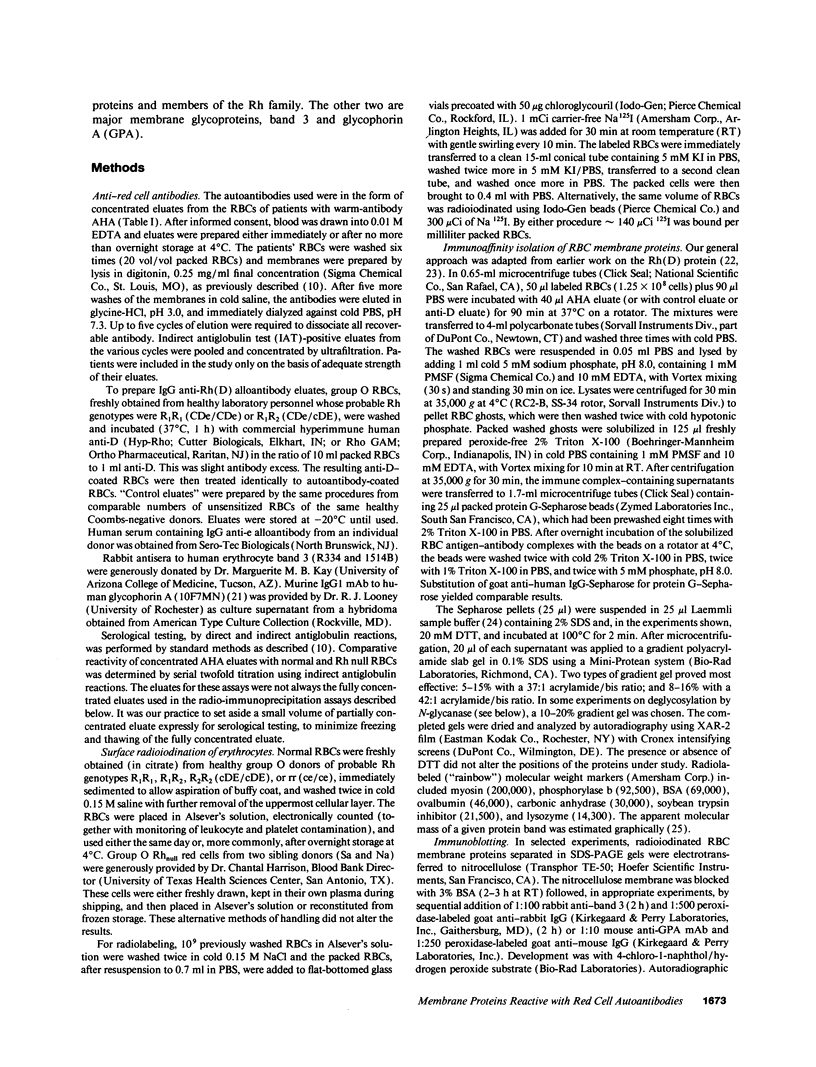
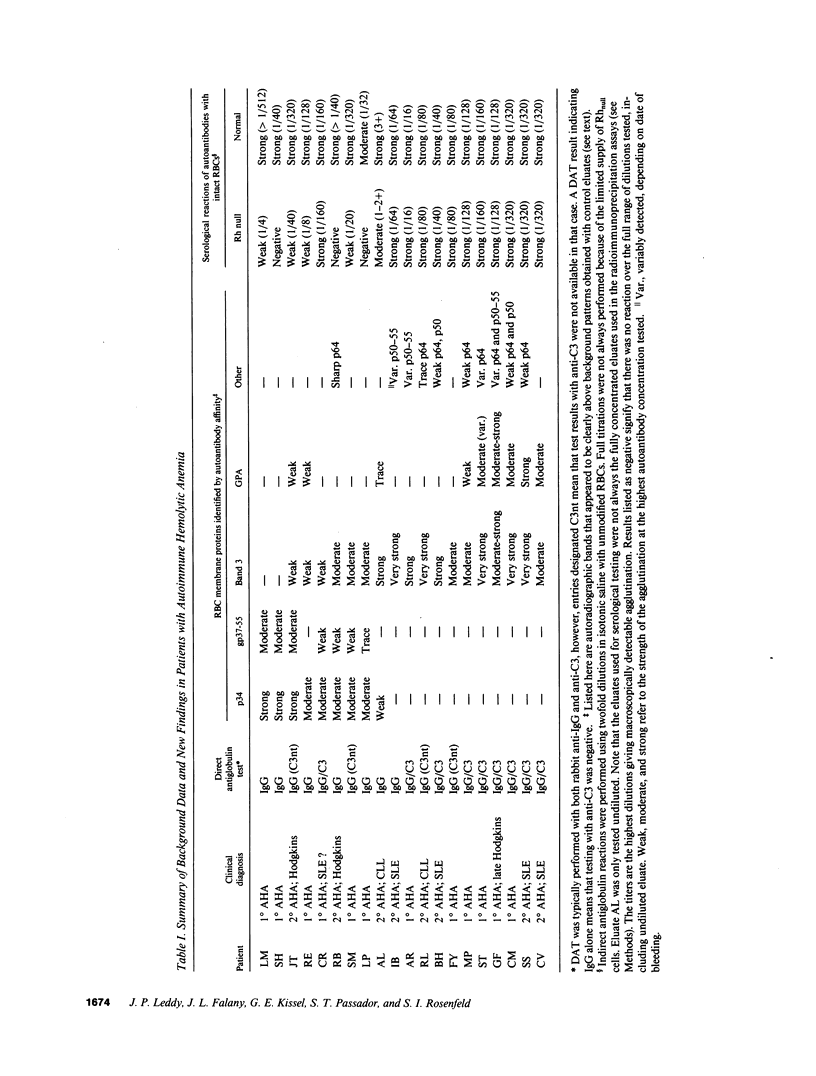
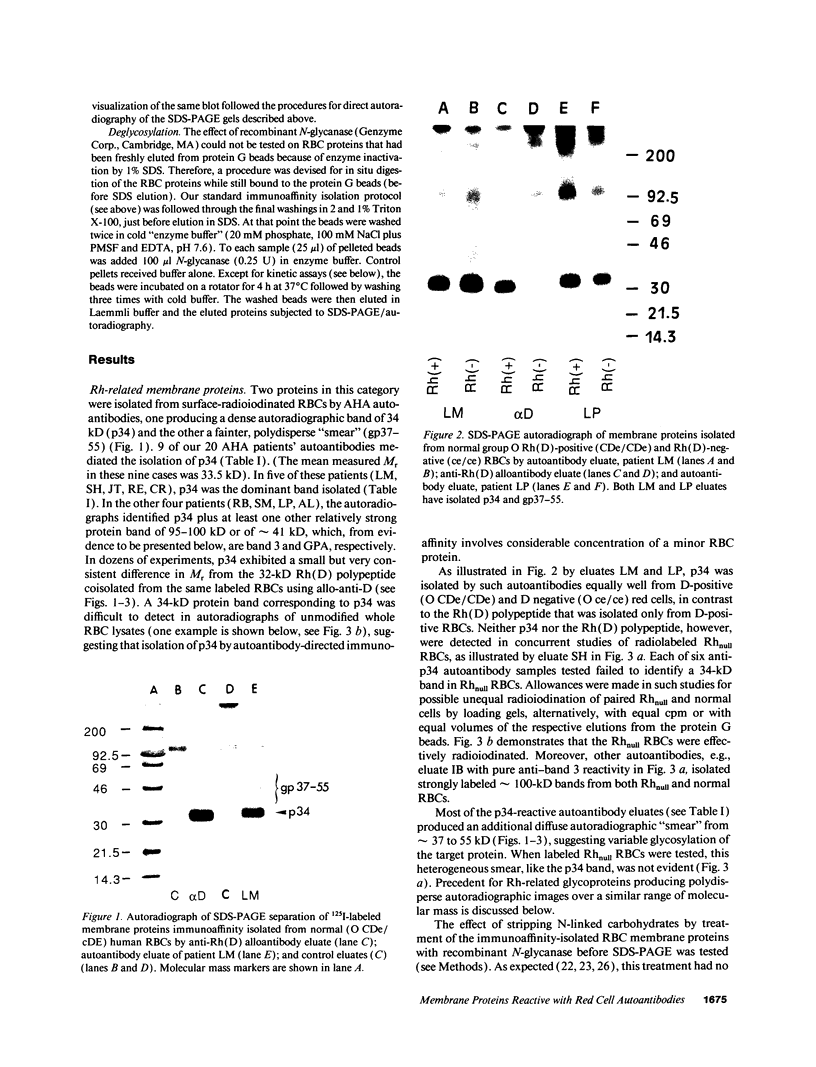

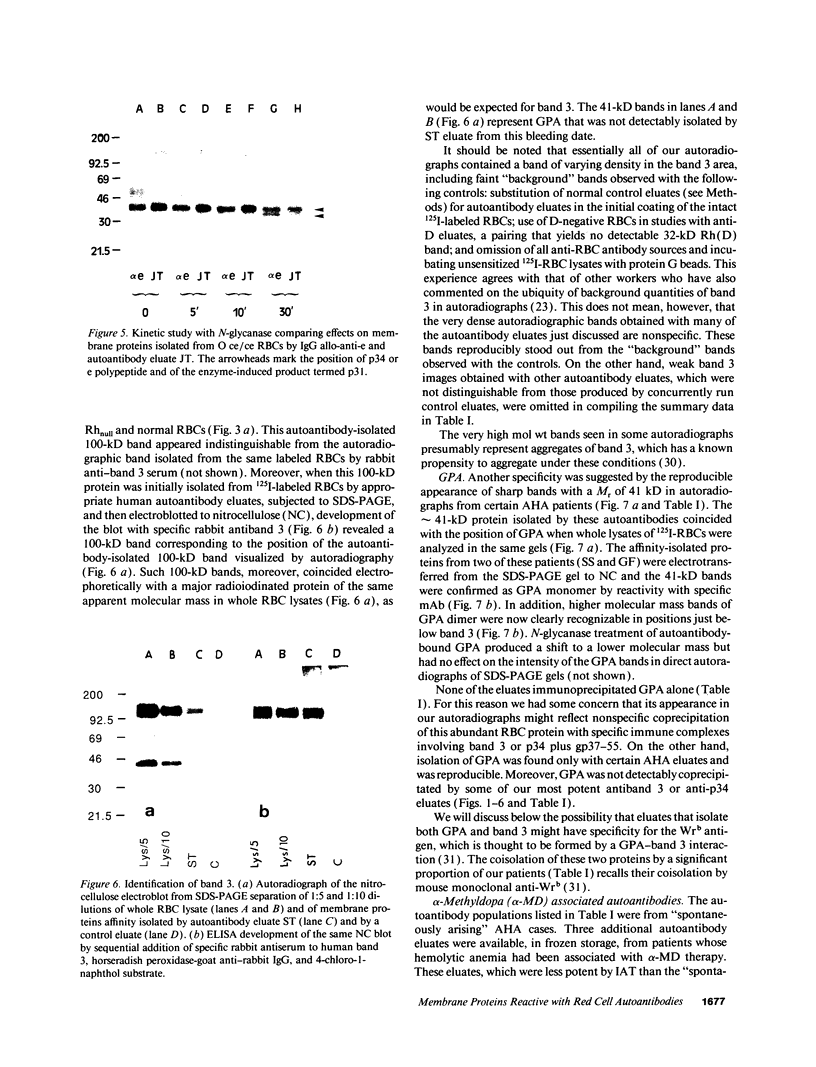
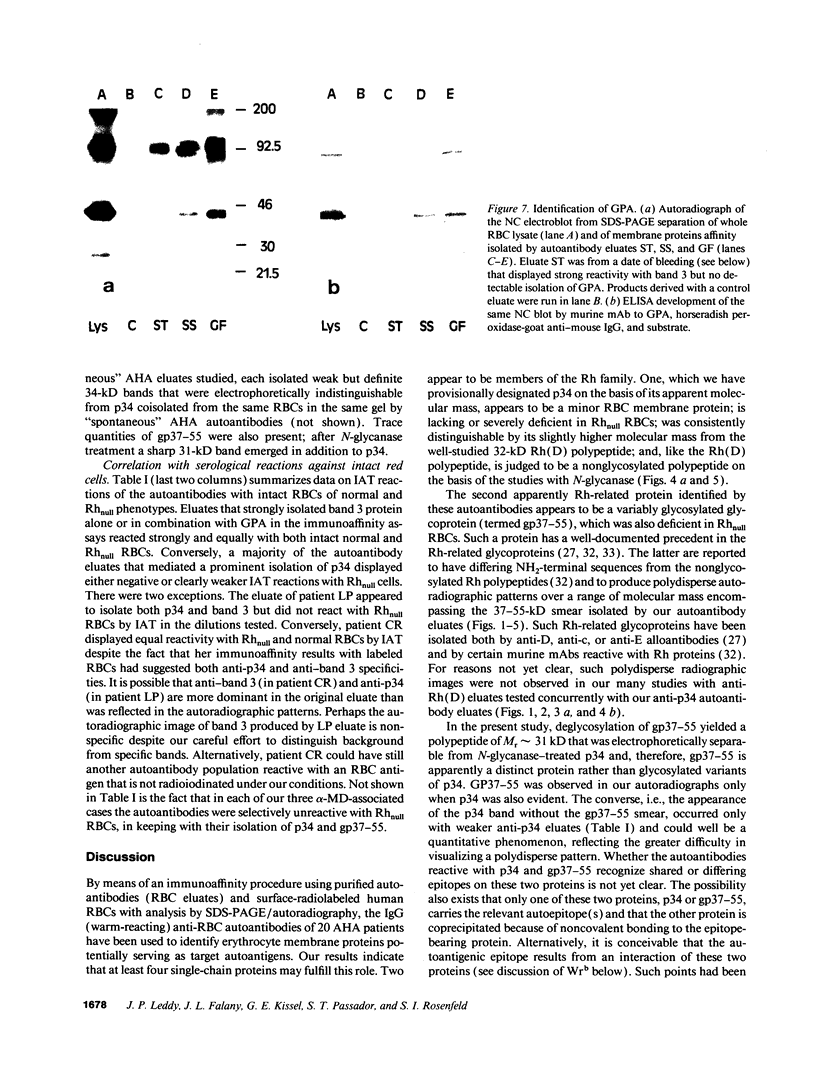
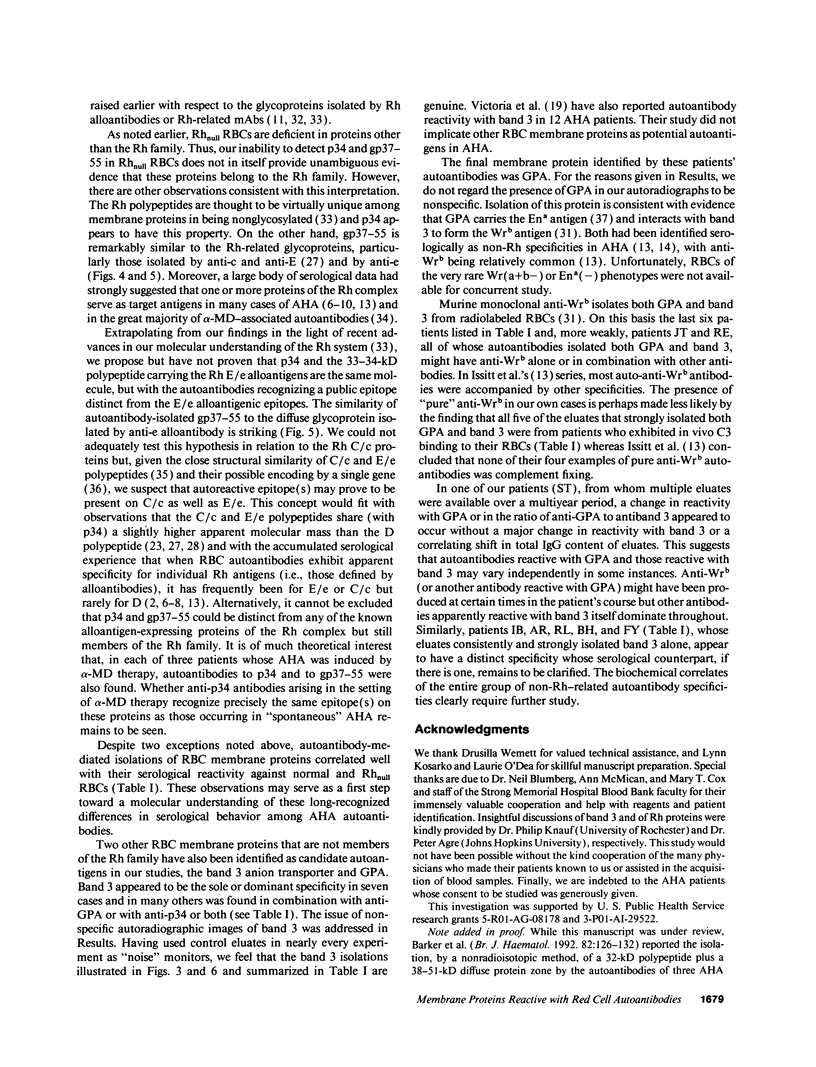

Images in this article
Selected References
These references are in PubMed. This may not be the complete list of references from this article.
- Agre P., Cartron J. P. Molecular biology of the Rh antigens. Blood. 1991 Aug 1;78(3):551–563. [PubMed] [Google Scholar]
- Avent N. D., Ridgwell K., Mawby W. J., Tanner M. J., Anstee D. J., Kumpel B. Protein-sequence studies on Rh-related polypeptides suggest the presence of at least two groups of proteins which associate in the human red-cell membrane. Biochem J. 1988 Dec 15;256(3):1043–1046. doi: 10.1042/bj2561043. [DOI] [PMC free article] [PubMed] [Google Scholar]
- Avent N., Judson P. A., Parsons S. F., Mallinson G., Anstee D. J., Tanner M. J., Evans P. R., Hodges E., Maciver A. G., Holmes C. Monoclonal antibodies that recognize different membrane proteins that are deficient in Rhnull human erythrocytes. One group of antibodies reacts with a variety of cells and tissues whereas the other group is erythroid-specific. Biochem J. 1988 Apr 15;251(2):499–505. doi: 10.1042/bj2510499. [DOI] [PMC free article] [PubMed] [Google Scholar]
- Bell C. A., Zwicker H. Further studies on the relationship of anti-Ena and anti-Wrb in warm autoimmune hemolytic anemia. Transfusion. 1978 Sep-Oct;18(5):572–575. doi: 10.1046/j.1537-2995.1978.18579036389.x. [DOI] [PubMed] [Google Scholar]
- Bigbee W. L., Vanderlaan M., Fong S. S., Jensen R. H. Monoclonal antibodies specific for the M- and N-forms of human glycophorin A. Mol Immunol. 1983 Dec;20(12):1353–1362. doi: 10.1016/0161-5890(83)90166-9. [DOI] [PubMed] [Google Scholar]
- Blanchard D., Bloy C., Hermand P., Cartron J. P., Saboori A. M., Smith B. L., Agre P. Two-dimensional iodopeptide mapping demonstrates that erythrocyte Rh D, c, and E polypeptides are structurally homologous but nonidentical. Blood. 1988 Oct;72(4):1424–1427. [PubMed] [Google Scholar]
- Celano M. J., Levine P. Anti-LW specificity in autoimmune acquired hemolytic anemia. Transfusion. 1967 Jul-Aug;7(4):265–268. doi: 10.1111/j.1537-2995.1967.tb05515.x. [DOI] [PubMed] [Google Scholar]
- Colin Y., Chérif-Zahar B., Le Van Kim C., Raynal V., Van Huffel V., Cartron J. P. Genetic basis of the RhD-positive and RhD-negative blood group polymorphism as determined by Southern analysis. Blood. 1991 Nov 15;78(10):2747–2752. [PubMed] [Google Scholar]
- Dacie J. V., Worlledge S. M. Auto-immune hemolytic anemias. Prog Hematol. 1969;6:82–120. [PubMed] [Google Scholar]
- Gahmberg C. G. Molecular characterization of the human red cell Rho(D) antigen. EMBO J. 1983;2(2):223–227. doi: 10.1002/j.1460-2075.1983.tb01409.x. [DOI] [PMC free article] [PubMed] [Google Scholar]
- Gahmberg C. G. Molecular identification of the human Rho (D) antigen. FEBS Lett. 1982 Apr 5;140(1):93–97. doi: 10.1016/0014-5793(82)80528-0. [DOI] [PubMed] [Google Scholar]
- Issitt P. D., Pavone B. G. Critical re-examination of the specificity of auto-anti-Rh antibodies in patients with a positive direct antiglobulin test. Br J Haematol. 1978 Jan;38(1):63–74. doi: 10.1111/j.1365-2141.1978.tb07109.x. [DOI] [PubMed] [Google Scholar]
- Issitt P. D., Pavone B. G., Goldfinger D., Zwikder H., Issitt C. H., Tessel J. A., Kroovand S. W., Bell C. A. Anti-Wrb, and other autoantibodies responsible for positive direct antiglobulin tests in 150 individuals. Br J Haematol. 1976 Sep;34(1):5–18. doi: 10.1111/j.1365-2141.1976.tb00168.x. [DOI] [PubMed] [Google Scholar]
- JANDL J. H., JONES A. R., CASTLE W. B. The destruction of red cells by antibodies in man. I. Observations of the sequestration and lysis of red cells altered by immune mechanisms. J Clin Invest. 1957 Oct;36(10):1428–1459. doi: 10.1172/JCI103542. [DOI] [PMC free article] [PubMed] [Google Scholar]
- Laemmli U. K. Cleavage of structural proteins during the assembly of the head of bacteriophage T4. Nature. 1970 Aug 15;227(5259):680–685. doi: 10.1038/227680a0. [DOI] [PubMed] [Google Scholar]
- Le Van Kim C., Chérif-Zahar B., Raynal V., Mouro I., Lopez M., Cartron J. P., Colin Y. Multiple Rh messenger RNA isoforms are produced by alternative splicing. Blood. 1992 Aug 15;80(4):1074–1078. [PubMed] [Google Scholar]
- Leddy J. P., Peterson P., Yeaw M. A., Bakemeier R. F. Patterns of serologic specificity of human gamma-G erythrocyte autoantibodies. Correlation of antibody specificity with complement-fixing behavior. J Immunol. 1970 Sep;105(3):677–686. [PubMed] [Google Scholar]
- Leddy J. P., Whittemore N. B., Weed R. I. Human erythrocyte membranes: effect of lipid extraction on binding of IgG ("warm") autoantibodies and Rh isoantibodies. Vox Sang. 1970 Nov-Dec;19(5):444–450. doi: 10.1111/j.1423-0410.1970.tb01775.x. [DOI] [PubMed] [Google Scholar]
- Marsh W. L., Oyen R., Alicea E., Linter M., Horton S. Autoimmune hemolytic anemia and the Kell blood groups. Am J Hematol. 1979;7(2):155–162. doi: 10.1002/ajh.2830070208. [DOI] [PubMed] [Google Scholar]
- Marsh W. L., Reid M. E., Scott E. P. Autoantibodies of U blood group specificity in autoimmune hemolytic anaemia. Br J Haematol. 1972 May;22(5):625–629. doi: 10.1111/j.1365-2141.1972.tb05709.x. [DOI] [PubMed] [Google Scholar]
- Moore S., Green C. The identification of specific Rhesus-polypeptide-blood-group-ABH-active-glycoprotein complexes in the human red-cell membrane. Biochem J. 1987 Jun 15;244(3):735–741. doi: 10.1042/bj2440735. [DOI] [PMC free article] [PubMed] [Google Scholar]
- Moore S., Woodrow C. F., McClelland D. B. Isolation of membrane components associated with human red cell antigens Rh(D), (c), (E) and Fy. Nature. 1982 Feb 11;295(5849):529–531. doi: 10.1038/295529a0. [DOI] [PubMed] [Google Scholar]
- NIH conference. Pathophysiology of immune hemolytic anemia. Ann Intern Med. 1977 Aug;87(2):210–222. doi: 10.7326/0003-4819-87-2-210. [DOI] [PubMed] [Google Scholar]
- Ridgwell K., Spurr N. K., Laguda B., MacGeoch C., Avent N. D., Tanner M. J. Isolation of cDNA clones for a 50 kDa glycoprotein of the human erythrocyte membrane associated with Rh (rhesus) blood-group antigen expression. Biochem J. 1992 Oct 1;287(Pt 1):223–228. doi: 10.1042/bj2870223. [DOI] [PMC free article] [PubMed] [Google Scholar]
- Steck T. L. The band 3 protein of the human red cell membrane: a review. J Supramol Struct. 1978;8(3):311–324. doi: 10.1002/jss.400080309. [DOI] [PubMed] [Google Scholar]
- Suyama K., Goldstein J. Antibody produced against isolated Rh(D) polypeptide reacts with other Rh-related antigens. Blood. 1988 Nov;72(5):1622–1626. [PubMed] [Google Scholar]
- Tanner M. J., Anstee D. J. The membrane change in En(a-) human erythrocytes. Absence of the major erythrocyte sialoglycoprotein. Biochem J. 1976 Feb 1;153(2):271–277. doi: 10.1042/bj1530271. [DOI] [PMC free article] [PubMed] [Google Scholar]
- Telen M. J., Chasis J. A. Relationship of the human erythrocyte Wrb antigen to an interaction between glycophorin A and band 3. Blood. 1990 Aug 15;76(4):842–848. [PubMed] [Google Scholar]
- Victoria E. J., Pierce S. W., Branks M. J., Masouredis S. P. IgG red blood cell autoantibodies in autoimmune hemolytic anemia bind to epitopes on red blood cell membrane band 3 glycoprotein. J Lab Clin Med. 1990 Jan;115(1):74–88. [PubMed] [Google Scholar]
- Vos G. H., Petz L., Fudenberg H. H. Specificity of acquired haemolytic anaemia autoantibodies and their serological characteristics. Br J Haematol. 1970 Jul;19(1):57–66. doi: 10.1111/j.1365-2141.1970.tb01601.x. [DOI] [PubMed] [Google Scholar]
- WEINER W., VOS G. H. SEROLOGY OF ACQUIRED HEMOLYTIC ANEMIAS. Blood. 1963 Nov;22:606–613. [PubMed] [Google Scholar]
- Wakui H., Imai H., Kobayashi R., Itoh H., Notoya T., Yoshida K., Nakamoto Y., Miura A. B. Autoantibody against erythrocyte protein 4.1 in a patient with autoimmune hemolytic anemia. Blood. 1988 Aug;72(2):408–412. [PubMed] [Google Scholar]
- Weber K., Osborn M. The reliability of molecular weight determinations by dodecyl sulfate-polyacrylamide gel electrophoresis. J Biol Chem. 1969 Aug 25;244(16):4406–4412. [PubMed] [Google Scholar]
- Worlledge S. M. Immune drug-induced haemolytic anemias. Semin Hematol. 1969 Apr;6(2):181–200. [PubMed] [Google Scholar]



